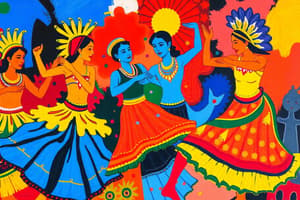Podcast
Questions and Answers
Ethnic dance in the Philippines is primarily influenced by Western culture.
Ethnic dance in the Philippines is primarily influenced by Western culture.
False
The Banga dance represents the tradition of a tribe known for their gentle demeanor.
The Banga dance represents the tradition of a tribe known for their gentle demeanor.
False
Dances during the Pre-Colonial Period in the Philippines were highly refined and artistically developed.
Dances during the Pre-Colonial Period in the Philippines were highly refined and artistically developed.
False
The term 'Cordillera' was assigned by the Spanish Conquistadors to refer to the mountain ranges of Northern Luzon.
The term 'Cordillera' was assigned by the Spanish Conquistadors to refer to the mountain ranges of Northern Luzon.
Signup and view all the answers
The Banga dance involves the use of pots as a central element in its performance.
The Banga dance involves the use of pots as a central element in its performance.
Signup and view all the answers
European dances had a significant influence on the development of Philippine folk dances.
European dances had a significant influence on the development of Philippine folk dances.
Signup and view all the answers
The Maria Clara dance is named after a character from a poem by Jose Rizal.
The Maria Clara dance is named after a character from a poem by Jose Rizal.
Signup and view all the answers
The Cariñosa dance originated in the Mindanao region of the Philippines.
The Cariñosa dance originated in the Mindanao region of the Philippines.
Signup and view all the answers
Bamboo castanets and the abanico are commonly used in Maria Clara dances.
Bamboo castanets and the abanico are commonly used in Maria Clara dances.
Signup and view all the answers
The Bicol Region has a version of the Cariñosa dance that uses one handkerchief.
The Bicol Region has a version of the Cariñosa dance that uses one handkerchief.
Signup and view all the answers
Study Notes
Pre-Colonial Period
- Dances viewed as pure expression, unrefined by formal training or artistic guidance.
- Integral to community life, tied to rituals and ceremonies.
- Ethnic dances represent various ethnolinguistic groups, especially in Northern Luzon.
- Cordillera dances symbolize the cultural heritage of the mountain regions, named after Spanish conquistadors.
- "Banga" (pot dance) illustrates the grace of Kalinga tribe warriors, showcasing communal and cultural identity.
Spanish Colonial Period
- Filipino dance evolved through the incorporation of European influences over four centuries.
- Filipino adaptations softened the sharp, fast European movements, integrating local elegance.
- Maria Clara dance represents Western influence; popular in urban settings around the turn of the century.
- Named after Maria Clara, a character in Jose Rizal's "Noli Me Tangere", symbolizing Filipina virtues.
- Utilizes bamboo castanets and abanico (fan), featuring traditional attire like the Maria Clara dress and barong tagalog.
- Example: "Cariñosa," linked to Spanish dances, with regional variations such as in Bicol where handkerchiefs are used uniquely.
American Colonial Period
- Bodabil dancing emerged, combining American popular and theatrical dance styles with Philippine folk dances.
- Rural dances reflect the Filipino "fiesta spirit," celebrating life's joys and work.
- Typical attire includes colorful balintawak and patadyong skirts for women, and camisa de chino for men.
- "Binasuan," a folk dance from Bayambang, Pangasinan, involves balancing glasses of rice wine, performed at weddings and festivals.
General Classification of Philippine Dances
- National dances are widespread, with minimal regional modification (e.g., Rigodon, Carinosa).
- Local dances are specific to certain areas (e.g., Tinikling in Leyte).
- Dances classified by nature include:
- Occupational dances depict specific occupations or labor.
- Religious dances performed during ceremonies.
- Comic dances for entertainment, showcasing humorous movements.
- Game dances incorporate playful elements.
- Wedding dances celebrated during marriage festivities.
Studying That Suits You
Use AI to generate personalized quizzes and flashcards to suit your learning preferences.
Related Documents
Description
Explore the rich tapestry of Filipino dance from the pre-colonial period to the Spanish colonial era. This quiz highlights how dances serve as expressions of cultural identity and evolve through external influences, showcasing important elements like the 'Banga' dance and the Maria Clara dance. Test your knowledge on the significance of these traditional dances and their impact on Filipino culture.




